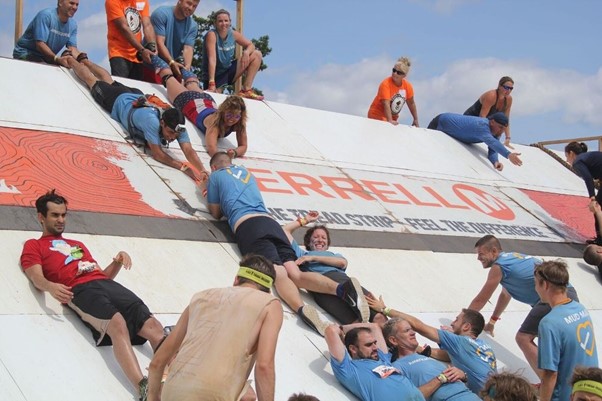[vc_row][vc_column][vc_column_text]Have you ever participated in Tough Mudder? It’s a crazy fitness challenge with all kinds of obstacles to overcome. Personally, I’ve never felt the urge to commando crawl through mud or jump into icy water, but Sharon did it once – in a red morph suit (yes, you can bribe me for the photos). One of the big obstacles is an insanely huge wall that’s too big for anyone to climb. The only way you can get over the top is by teamwork, with others willing to let you climb on their shoulders and then you help pull them up.
We often talk about partnerships needing a whole of team effort. It needs an extra level of effort and coordination when you work in an organisation that’s a federated model. Too often we hear of competition between states or branches which can be a major obstruction to bigger partnerships. Corporates don’t see the internal structures, they just want to partner with an organisation that looks like it operates nationally.
It is perfectly possible to work together across boundaries to win a high value, significant partnership. I did it years ago with Save the Children and we managed to coordinate internationally, across countries. Here are some insights I gained along the way.
Home HQ leads the relationship
Corporates like the opportunity to deal face to face with a key charity. It makes it easier to allow the state or location where the corporate is headquartered to take the lead with the relationship. You can invite them to events, facilitate site visits and nurture the relationship easier. That’s why my colleagues in Sweden managed the IKEA global partnership and the team in the UK took the lead with Glaxosmithkline.
Build a coalition
If you’re going after a national partnership you need everyone at the table, communicating often and sharing expertise and insights. You may have partnership managers in each state who manage local relationships, but you need a collaborative approach to a large corporate with national reach. Regular forums and simple protocols can be all you need to create trust between teams. You will have a primary relationship manager for the partnership, but everyone needs to be on the same page about their role to support it.
When I worked on a global partnership with Procter & Gamble, our working group decided that the first countries to go live with a cause marketing campaign would be Australia & New Zealand. I like to think they considered us Aussies as early adopters, but I suspect that the P&G HQ also thought that if it failed, then no-one would notice! The campaign was a success, and we were able to feed insights and learnings back to the USA office so they could refine the bigger American rollout to come. The working group met regularly, shared information generously and supported each other. The total raised from the global campaign was in the millions at the end, which funded life saving health programs across the world.
Revenue sharing and KPIs
This is always a sticky point in a federated model. Each state organisation is independent, with its own revenue targets, reporting to a different board. But again, the corporate partner only sees the same name, same brand and logo everywhere- and expects you to behave nationally.
The Save the Children global partnership coalition developed protocols for revenue sharing across national boundaries. Revenue earned in each location as attributed to profit and loss there, but a percentage was returned to the home HQ country to cover the costs of the principal relationship management activities.
Some organisations have moved to a national model to remove some of the difficulties of a federated model. But if I could do it across national boundaries, with teams from Sweden, Italy, India, USA, UK, Australia and Japan then there’s no reason it can’t be done across Australia itself. Corporates buy into your mission and want to do something significant for the community. Don’t let your internal organisational structure stand in their way. Put in place some simple processes and you won’t be relegated to local business relationships.
If you want to get over that daunting Tough Mudder wall, you need to stand on someone’s shoulders and lend a hand to pull up your colleagues. Only then will you get to the finish line before everyone else.[/vc_column_text][/vc_column][/vc_row][vc_row][vc_column width=”1/2″][vc_custom_heading text=”Don’t miss a blog. Sign up to our weekly newsletter.” use_theme_fonts=”yes”][vc_column_text]
[/vc_column_text][/vc_column][vc_column width=”1/2″][/vc_column][/vc_row]
